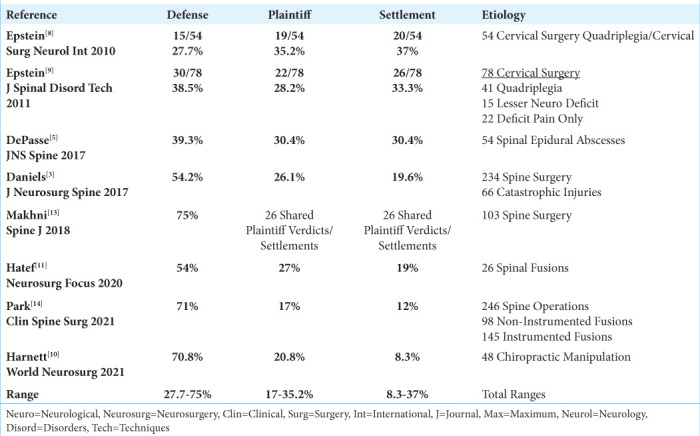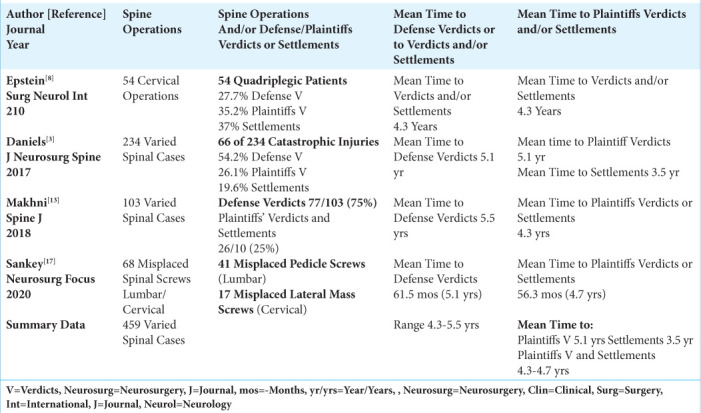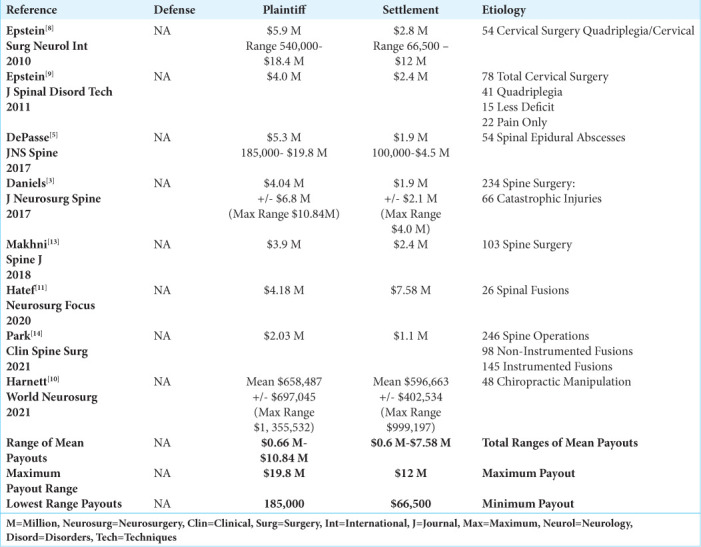Abstract
Background:
Why are spine surgeons sued, how successfully, and for how much? Typical bases for spinal medicolegal suits have included; the failure to timely diagnose and treat, surgical negligence, (i.e. especially resulting in significant neurological deficits), and the lack of informed consent. We reviewed 17 medicolegal spinal articles looking for additional reasons for suits, along with identifying other factors contributing to defense verdicts, plaintiffs’ verdicts, or settlements.
Methods:
After confirming the same three most likely causes of medicolegal suits, other factors leading to such suits included; the lack of patient access to surgeons postoperatively, poor postoperative management (i.e. contributing to new postoperative neurological deficits), failure to communicate between specialists/surgeons perioperatively, and failure to brace.
Results:
Critical factors leading to more plaintiffs’ verdicts and settlements along with higher payouts for both included new severe and/or catastrophic postoperative neurological deficits. Conversely, defense verdicts were more likely for those with less severe new and/or residual injuries. The total number of plaintiffs’ verdicts ranged from 17-35.2%, settlements, from 8.3-37%, and defense verdicts from 27.7-75%.
Conclusion:
The three most frequent bases for spinal medicolegal suits continue to include; failure to timely diagnose/treat, surgical negligence, and lack of informed consent. Here, we identified the following additional causes of such suits; the lack of patient access to surgeons perioperatively, poor postoperative management, lack of specialist/surgeon communication, and failure to brace. Further, more plaintiffs’ verdicts or settlements and greater respective payouts were observed for those with new and/or more severe/catastrophic deficits, while more defense verdicts were typically rendered for patients with lesser new neurological injuries.
Keywords: Malpractice suits, Spine surgery, Orthopedics, Neurosurgery, Negligent surgery, Failure to diagnose/ treat, Lack of Informed consent, Defense and plaintiffs’ verdicts, Settlements, Payouts, Catastrophic neurological injury

INTRODUCTION
In this review of 17 medicolegal spine studies, we confirmed that the three major bases for spinal medicolegal suits still included; the failure to diagnose and treat in a timely fashion, negligent surgery, and the lack of informed consent [Table 1]. Further, we looked at other additional risk factors which uniquely contributed to plaintiffs’ verdicts or settlements vs. defense verdicts [Tables 2-4].
Table 1:
Literature on malpractice claims.

Table 2:
Summary of defense, plaintiffs verdicts and settlements.

Table 4:
Time until defense or plaintiffs’ verdicts or settlements.

Reasons for Medicolegal Suits in Spine Surgery
Failure to diagnose and treat in a timely fashion
Various studies cite different reasons for medicolegal suits involving spine surgery [Table 1].[1-3,7-9] Epstein in 2010 found that two of the major reasons for cervical spine medicolegal suits involving 54 quadriplegic patients included (i.e. in descending/overlapping order); negligent surgery (47 cases), and failure to timely diagnose and treat (33 cases) [Table 1].[8] In a separate study in 2011, Epstein cited the same 2 dominant reasons for filing medicolegal spinal suits, but now 41 patients in this other sample were quadriplegic, 15 showed less severe neurological deficits, and 22 had pain alone. Notably, this series included 37 patients with “less severe” neurological deficits that resulted in an increase in defense verdicts (i.e. 27.7% defense verdicts in the 2010 series vs. the higher 38.5% in the 2011 study) [Tables 2-4].[9] Daniels et al. (2012) cited the failure to timely diagnose/treat lumbar cauda equina syndromes as the major contributing factor leading to plaintiffs’ verdicts in their series [Table 1].[2] In a separate study by a different Daniels et al. in (2017), where 66 out of 234 spine patients sustained postoperative catastrophic neurological injuries, the main factors contributing to plaintiffs’ verdicts or settlements were delays in obtaining a timely diagnosis and administering treatment (i.e. 42.9% plaintiffs’ verdicts vs. 72.7% settlements) [Tables 1-4].[3] As anticipated, mean payouts for plaintiffs’ verdicts (i.e. $4.04 M +/- $6.8 M) were significantly higher than for settlements (i.e. $1.9 M +/- $2.1 M); both plaintiffs’ verdicts and settlement payouts were also markedly increased by catastrophic injuries. For Durand’s 48 patients sustaining incidental intraoperative durotomies (i.e. DT-dural tears), delays in the timely diagnosis/treatment also favored plaintiffs’ verdicts (i.e. with delays 61.9% plaintiffs’ verdicts vs. 29.6% plantiffs’ verdicts without delays) [Table 1].[7] Agarwal et al. (2018), in 98 spinal medicolegal cases (Westlaw Legal Database), separately cited the failure to diagnose (31.6% cases) and treat (32.6% of cases) along with death and surgical emergencies as major causes/contributors to plaintiffs’ verdicts [Table 1].[1]
Failure to diagnose/treat lumbar cauda equina syndromes (CES)
Using the LexisNexis Database, Daniels et al. (2012) examined the following multiple variables contributing to CES suits; whether a rectal exam was performed when the patient originally presented (i.e. typically the lack thereof), and the time it took for a specialist to see the patient, obtain imaging, and operate [Table 1]. They identified a; “positive association…between the time to surgery of > 48 hrs. and an adverse decision”.[2] Park et al., (2021) further found that plaintiffs’ verdicts were more likely if patients exhibited postoperative cauda equina syndromes (i.e. with CES 55% vs. without CES 26%).[14]
Failure to diagnose and treat spinal epidural abscesses (SEA)
DePasse et al. (2017) noted that their 56 suits were mostly against physicians who failed to diagnose a SEA; these predominantly included internists (23.2%), and emergeny room physicians (14.3%), with only 5.4% involving spinal orthopedic surgeons [Table 1].[5] Further, the more severe the deficits, the more likely plaintiffs’ verdicts and settlements would be rendered with higher payouts averaging $5.27 M, while settlements (30.4%) averaged 1.9 M.
Variables contributing to delays in diagnosis and treatment
In 4 studies, multiple variables contributed to delays in diagnosis and treatment [Table 1].[2,7,13] In Daniels et al. (2012) series focusing on cauda equina syndromes, major variables contributing to delays in diagnosis and treatment included; the site of initial evaluation, initially missed diagnoses, the failure to perform a rectal exam, and the time it took for a specialist to be consulted, to complete imaging, and perform surgery [Table 1].[2] They specifically found a; “Positive association between the time to surgery of over 48 hours and adverse decisions”. For Durand et al. (2018) 48 cases involving incidental durotomies, delays in diagnosis and treatment included the failure to recognize a recurrent postoperative cerebrospinal fluid (CSF) leak in a timely fashion, (i.e. delayed), or surgeons’ initial or subsequent “improper” (i.e. negligent) repair of a dural tear resulting in recurrent CSF fistulas [Table 1].[7] Other factors included; infection, wound dehiscence, and/or a new neural injury [Table 1].[7] Makhni et al. (2018) cited the following additional factors as contributing to spinal diagnostic/therapeutic delays; the presence of a nerve injury, involvement of an orthopedic surgeon, and wrong level surgery [Table 1].[13]
Surgical negligence
Several studies addressed negligent surgery/technical surgical errors as contributing to plaintiffs’ verdicts and settlements.[7-10, 14, 17] Epstein (2010) found that negligent surgery was a major reason for filing medical legal spine suits in 47 of 54 quadriplegic cases, and also played a significant role in the 2011 study (i.e. that included 41 of 78 quadriplegic patients).[8,9] Out of Durand et al. (2018) 48 patients sustaining intraoperative dural tears (DT), improper dural repair techniques largely accounted for the higher 72.7% rate of plaintiffs’ verdicts vs. a much lower 35.1% for those considered to have undergone appropriate DT repairs [Table 1].[7] Sankey et al. (2020) uniquely cited technical surgical negligence as the main reason for 68 spinal medicolegal suits (i.e. involving misplaced lumbar pedicle screws [41 patients], and cervical lateral mass screws [27 cases]) [Tables 1 and 4].[17] Harnett et al., (2021) observed that chiropractic manipulation was responsible for all 48 medicolegal spinal suits; this included 32 patients with new neurological injuries, 87.5% of whom subsequently required spinal surgery [Tables 1-3].[10] Looking at 257 malpractice spine cases from the Westlaw Legal Database, Park et al. (2021) found intraoperative technical errors/negligence (i.e. new deficits attributed to more multilevel instrumented fusions), and improper/poor postoperative management contributed to the 17% incidence of plaintiffs’ verdicts, and 12% settlements [Tables 1-3].[14]
Table 3:
Summary of amounts of plaintiffs verdicts

Negligent dural repair
Durand et al. (2018) analyzed 48 cases involving “incidental durotomies using three legal databases; they alleged delays in diagnosis/treatment (43.8%), or cited “improper durotomy repair” (22.9%) [Table 1].[7] Plaintiffs’ verdicts rose to 61.9% with delays in diagnosis and treatment vs. 29.6% without delays, while 72.7% of cases resulted in plaintiffs’ verdicts for “improper” DT repair techniques vs. 29.6% without. Interestingly, and consistent with our other findings, the number of defense verdicts markedly increased (i.e. to 83.3%) where patients exhibited no neurological deficits.
Negligent placement of spinal screws
In Sankey et al. (2020) 32 neurosurgeons and 31 orthopedists (31) were sued for 68 cases attributed to misplaced spinal screws, (i.e. 41 lumbar pedicle screws, 17 cervical lateral mass screws) [Table 1].[17] Combined plaintiffs verdicts/settlements paid an average of $1.2 M +/- $753,832.
Negligent surgery and failures of postoperative management contributed to more plaintiffs’ verdicts and settlements
Park et al. (2021) 257 spinal cases resulted in 17% plaintiffs’ verdicts, and 12% settlements largely attributed to: intraoperative errors/negligence in instrumented fusions, failures in postoperative management, and new postoperative neurological deficits [Table 1].[14] Plaintiffs verdicts were also more likely if patients exhibited new postoperative cauda equina syndromes (i.e. with CES 55% vs. no CES 26%), postoperative surgical site infections (SS) (i.e. with SSI 46% vs. 27% without), and new catastrophic neurological injuries (i.e. with injuries 40% vs. 26% without). Further, higher plaintiffs’ awards were associated with multilevel vs. 1-level instrumented fusions, poor postoperative management, and new/permanent postoperative neurological deficits.
Negligent failure to use intraoperative neural monitoring or improper intraoperative neural monitoring
Hatef et al. (2020) evaluated 26 medicolegal cases addressing failures to use intraoperative neural monitoring (IONM) (i.e. arguing the Standard of Care required monitoring), and “improper” or negligent monitoring (i.e. failure to appropriately respond/treat significant changes) [Tables 1-3].[11] Of interest, clinical outcomes were similar for both groups. The 19% plaintiffs’ verdicts (54% for failure to monitor, and 46% for negligent monitoring) resulted in an average $4.2 M awards, while the 27% settlements averaged substantially higher at $7.58 M; notably, there were 54% defense verdicts [Tables 2 and 3].
Negligent chiropractic manipulation
Harnett et al., (2021) evaluated 48 spinal medicolegal suits (Verdict Search) against chiropractors; 45 had undergone direct spinal manipulation that resulted in 32 new post-manipulation neurological deficits with 87.5% of these patients requiring surgery [Table 1].[10]
Lack of informed consent
Multiple studies raised lack of informed consent as a major reason for filing medicolegal suits [Table 1].[1,8,9,12,13] Epstein (2010) found that 23 of 54 quadriplegic patients cited lack of informed consent as a reason for bringing medicolegal suits [Table 1].[8] The separate 2011 study also cited lack of informed consent as a major contributor to filing such suits [Table 1].[9] In 24.4% of their 98 spinal suits drawn from the Westlaw Legal Database, Agarwal et al. (2018) stated the lack of informed consent played a major role in 24.4% of their 98 spinal suits [Table 1].[1] Reviewing 103 spine surgery malpractice cases culled from the WestlawNext Medicolegal database, Makhni et al. (2018) observed a higher 34% of patients who largely sued for the lack of informed consent [Tables 1-4].[13] When Jackson et al. (2021) reviewed “trends” identified in 23 spinal malpractice articles (i.e. from Medline and Embase Databases), they concluded that improvement in preoperative informed consent (i.e. better preoperative discussions of operative vs. non-operative management) could reduce the number spine malpractice actions in the future [Table 1].[12]
Other reasons for spinal malpractice suits
Other reasons were identified for patients filing spinal malpractice actions. [Table 1][6,16] When Dronkers et al. (2020) evaluated 57 complaints against neurosurgey attendings/residents (i.e. for 40 first instance, 17 appeals - 62.5% involving spine surgery) in the Netherlands, the predominant “complaints” included the lack of adequate communication between specialists/surgeons (i.e. preoperatively/perioperatively), and failures in postoperative care [Table 1].[6] Analyzing 214 complaints from 202 patients for spine-related malpractice events (i.e. involving 6 orthopedic spine surgeons over a 10 year period), Rae et al. (2022) further identified a 35% incidence of the “lack of access to the surgeons postoperatively”, and another 32% cited failures in postoperative care/treatment (i.e. including 34 dissatisfied with postoperative results) [Table 1].[16]
It is Not Just the Spine Surgeons Who are Sued
In spine malpractice cases, many suits were brought against treating physicians other than spinal surgeons [Table 1].[1,5,10,14,17] For DePasse et al. (2017) 56 cases involving spinal epidural abscesses, medicolegal suits were predominantly brought against internists (23.2%), and emergency room physicians (14.3%), followed by just 5.4% against orthopedic surgeons.[5] The major reason for the failures to “timely” diagnose/treat SEA in spine patients was primarily attributed to mistakes made by these “primary screeners”.
Variable Frequency of Medicolegal Suits Against Neurosurgeons, Orthopedic Surgeons, and Chiropractors
In Agarwal et al. (2018 study) 98 suits, spinal neurosurgeons were defendants in 17.3% of cases, while 23.8% were orthopedists.[1] Out of Sankey et al. (2020), 68 medical malpractice cases involving misplaced spinal screws, patients nearly equally sued neurosurgeons (32-47%) and orthopedists (31-45.6%).[17] Alternatively, for Park et al. (2021) non-instrumented vs. instrumented fusion series, more neurosurgeons (33%) than orthopedists (18%) were sued.[14] Notably, in Harnett et al. study (2021) chiropractors were sued for their direct roles in spinal manipulation in 45 of 48 malpractice cases [Table 1].[10]
Catastrophic Injuries and More Severe Neurological Deficits Led to More Plaintiffs’ Verdicts and Settlements
In our review of 17 medicolegal studies, greater neurological deficits and/or catastrophic injuries led to more frequent and higher plaintiffs verdicts and settlements, and fewer defense verdicts [Tables 1-3].[3,5,8,14] Epstein’s series involving 54 quadriplegic patients resulted in the highest percentage of plaintiffs verdicts (35.2%) and settlements (37%), and the smallest number (27.7%) of defense verdicts.[8] In Daniels et al. (2017) series, in which 66 of 234 malpractice claims involved catastrophic injuries, the results included 26.1% plaintiffs’ verdicts, with higher mean average payouts of $6.1 M vs. $2.9 M without such catastrophic injuries (average $4.04 M).[3] DePasse et al. (2017) series comprised of 54 patients with spinal epidural abscesses (SEA) and significant neurological deficits, demonstrated the second highest percentage of plaintiffs’ verdicts (30.4%), and third highest (30.4%) incidence of settlements.[5] In Park et al., (2021) although 17% of cases resulted in plaintiff’s verdicts, that percentage increased to 40% for patients with catastrophic neurological injuries (vs. 26% without), and these resulted in increased payouts (i.e. $2.29 M with new deficits vs. $0.78 M without).[14] Further, new postoperative cauda equina syndromes also increased the frequency of plaintiffs’ verdicts (i.e. with CES 55% plaintiffs’ verdicts vs. without CES 26%).[14]
Less Severe Neurological Deficits Correlated with More Defense Verdicts
More defense verdicts were observed in series where patients had less severe neurological deficits.[3,5,9-11,14] In Epstein’s (2011) series based on 41 of 78 quadriplegic patients, with 15 showing lesser neurological deficits, and 22 exhibiting pain alone, there were more defense verdicts (38.5%) compared with the 2010 study involving 54 quadriplegic patients (27.7%) [Table 2].[9] The incidence of defense verdicts in the remaining 15 studies, excluding Epstein’s 2 series, ranged from 39.2% to 75%, and included patients undergoing various types of spine operations, including fusions, and chiropractic manipulation [Tables 1-3].[3,5,11,14]
Highest Mean, and Highest and Lowest Payouts for Plaintiffs’ Verdicts
The mean payouts for plaintiffs verdicts ranged from $0.66 Million to $5.9M [Tables 1-3].[3,8,10] The largest mean of $5.9 M was paid to plaintiffs (i.e. 19 of 54 quadriplegic patients) in Epstein’s 2010 series. This was followed by the average of $5.3 M paid for plaintiffs’ verdicts in DePasse’s series of 54 patients with spinal epidural abscesses. The highest range of plaintiffs verdict payouts occurred in Depasse’s series, at $19.8 M (54 SEA patients), followed by $18.4 M in Epstein’s 2010 series (54 quadriplegic series), and by $10.84 M for Daniels’ 234 patients (66 with catastrophic injuries) undergoing a mixture of spinal procedures.[3,5,8] The lowest range of payouts for plaintiffs verdicts was $185,000 in DePasse’s 54 SEA, succeeded by $540,000 in Epstein’s 2010 series.[5,8]
Highest Mean, and Highest and Lowest Payouts for Settlements
The highest mean payouts for settlements ranged from $7.58 M for the 26 patients in Hatef ’s series undergoing spinal fusions, to $2.8 in Epstein’s 2010 and $2.4 M in Epstein’s 2011 studies respectively [Tables 1-3][8,9,11] The highest range of settlement was $12 M for Epstein’s 54 quadriplegic, followed by DePasse’s $4.5 M (i.e. for 54 SEA).[5,8] Notably, the lowest range for a settlement was $66,500 seen in Epstein’s 54 quadriplegic patients (2010), with Depasse’s $100,000 for the 54 patients with SEA being next.[5,8]
Mean Duration and Range of Times for Verdicts or Settlements to be Rendered
Four studies offered the mean and ranges of times until verdicts or settlements were reached [Table 4].[3,8,13,17] The mean range in years for defense verdicts across the 4 studies varied from 4.3 (i.e. mean time to verdicts and settlements) to 5.1 to 5.5 years. Plaintiffs verdicts alone were rendered at an average of 5.1 years, settlements at 3.5 years, and for combined plaintiffs verdicts/settlements at 4.3-4.7 years.
Medicolegal Suits Involved Multiple Different Spine Operations
Multiple types of spinal procedures led to medicolegal suits, [Table 1].[3,5,7,8,14,17] Epstein’s 2010 54 quadriplegic patients had undergone anterior (25 patients), posterior (22 patients), circumferential (1 patient), or undefined (6 cases) cervical procedures.[8] In 2011, the 78 cervical cases included 48 1-4 level anterior diskectomy-fusions/1 level anterior corpectomyfusions, 20 posterior cervical procedures (7 fusions, 13 laminectomy/fusions), 2 other “procedures”, while 9 procedures were unstated.[9] Multiple other surgeons performed different surgical approaches at various other spinal levels; Depasse operated on 56 spinal epidural abscesses, Daniels (2017) performed 234 spinal cases, Durand dealt with 48 lumbar dural tears, Sankey identified 41 patients with misplaced spinal screws, and Park performed a combination of 83 decompressions, 95 decompressions/fusions, and 47 fusions alone.[3,5,7,14,17]
Spinal Litigation in England: A Report from the National Health Service (NHS)
Quraishi et al. (2012) focused on the costs of spinal litigation to the National Health Service in England vs. the costs to claimants within their socialized medical system [Table 1].[15] Using a Litigation Authority Database of Successful Spinal Claims 2002-2010, 235 cases (i.e. 144 were acute, and 91 were elective procedures), the total cost of claims was 60.5 Million pounds, with 31% of the costs borne by the NHS.
CONCLUSION
Most medicolegal spinal suits arise from the failure to timely diagnosis/treat a spinal problem, negligent surgery, the lack of informed consent, limited access of patients to their surgeons perioperatively, poor postoperative management, and failures of communication between specialists/surgeons [Table 1]. The more severe/catastrophic the postoperative neurological deficits, the more plaintiffs’ verdicts and settlements were rendered, along with higher payouts for both groups [Tables 2-3].
Footnotes
How to cite this article: Epstein NE, Agulnick MA. Why are spine surgeons sued, and with what outcomes? Surg Neurol Int 2023;14:46.
Contributor Information
Nancy E. Epstein, Email: nancy.epsteinmd@gmail.com.
Marc A. Agulnick, Email: marc_agulnick@yahoo.com.
Declaration of patient consent
Patient’s consent not required as there are no patients in this study.
Financial support and sponsorship
Nil.
Conflicts of interest
There are no conflicts of interest.
Disclaimer
The views and opinions expressed in this article are those of the authors and do not necessarily reflect the official policy or position of the Journal or its management. The information contained in this article should not be considered to be medical advice; patients should consult their own physicians for advice as to their specific medical needs.
REFERENCES
- 1.Agarwal N, Gupta R, Agarwal P, Matthew P Wolferz Jr, Shah A, et al. Descriptive analysis of state and federal spine surgery malpractice litigation in the United States Spine. Phila Pa 1976. 2018;43:984–90. doi: 10.1097/BRS.0000000000002510. [DOI] [PubMed] [Google Scholar]
- 2.Daniels EW, Gordon Z, French K, Ahn UM, Ahn NU. Review of medicolegal cases for cauda equina syndrome: What factors lead to an adverse outcome for the provider? Orthopedics. 2012;35:e414–9. doi: 10.3928/01477447-20120222-15. [DOI] [PubMed] [Google Scholar]
- 3.Daniels AH, Ruttiman R, Eltorai AE, DePasse JM, Brea BA, Palumbo MA. Malpractice litigation following spine surgery. J Neurosurg Spine. 2017;27:470–5. doi: 10.3171/2016.11.SPINE16646. [DOI] [PubMed] [Google Scholar]
- 4.de Macedo Filho LJ, Aragao AC, Moura IA, Olivier LB, Albuquerque LA. Malpractice and socioeconomic aspects in neurosurgery: A developing-country reality. Neurosurg Focus. 2020;49:E13. doi: 10.3171/2020.8.FOCUS20571. [DOI] [PubMed] [Google Scholar]
- 5.DePasse JM, Ruttiman R, Eltorai AE, Palumbo MA, Daniels AH. Assessment of malpractice claims due to spinal epidural abscess. J Neurosurg Spine. 2017;27:476–80. doi: 10.3171/2016.12.SPINE16814. [DOI] [PubMed] [Google Scholar]
- 6.Dronkers WJ, Amelink QJ, Buis DR, Broeckman ML, Spoor JK. Disciplinary law and neurosurgery: A 10-year analysis of cases in the Netherlands. Neurosurg Focus. 2020;49:E9. doi: 10.3171/2020.8.FOCUS20561. [DOI] [PubMed] [Google Scholar]
- 7.Durand WM, Eltorai AE, Shantharam G, DePasse JM, Kuris EO, Hersey AE, et al. Medical malpractice claims following incidental durotomy due to spinal surgery spine. Phila Pa 1976. 2018;43:940–5. doi: 10.1097/BRS.0000000000002469. [DOI] [PubMed] [Google Scholar]
- 8.Epstein NE. A medico-legal review of cases involving quadriplegia following cervical spine surgery: Is there an argument for a no-fault compensation system? Surg Neurol Int. 2010;1:3. doi: 10.4103/2152-7806.62261. [DOI] [PMC free article] [PubMed] [Google Scholar]
- 9.Epstein NE. A review of medicolegal malpractice suits involving cervical spine: What can we learn or change? J Spinal Disord Tech. 2011;24:15–9. doi: 10.1097/BSD.0b013e3181c752ab. [DOI] [PubMed] [Google Scholar]
- 10.Harnett DA, Milner JD, Kleinhenz Kuris EO, Daniels AH. Malpractice litigation involving chiropractic spinal manipulation. World Neurosurg. 2021;149:e108–15. doi: 10.1016/j.wneu.2021.02.067. [DOI] [PubMed] [Google Scholar]
- 11.Hatef J, Katzir M, Toop N, Islam M, Clark T, Roscoe C, et al. Damned if you monitor, damned if you don’t: Medical malpractice and intraoperative neuromonitoring for spinal surgery. Neurosurg Focus. 2020;49:E19. doi: 10.3171/2020.8.FOCUS20580. [DOI] [PubMed] [Google Scholar]
- 12.Jackson KL, Rumley J, Griffith M, Linkous T, Abochukwu U, Devine J. Medical malpractice claims and mitigation strategies following spine surgery. Global Spine J. 2021;11:782–91. doi: 10.1177/2192568220939524. [DOI] [PMC free article] [PubMed] [Google Scholar]
- 13.Makhni MC, Park PJ, Jimenez J, Saifi C, Caldwell JM, Ha A, et al. The medicolegal landscape of spine surgery: How do surgeons fare? Spine J. 2018;18:209–15. doi: 10.1016/j.spinee.2017.06.038. [DOI] [PubMed] [Google Scholar]
- 14.Park HY, Hwang R, Sheppard WL, Blumstein G, Shah AA, Medina JA, et al. Predictors of medical malpractice outcomes after spine surgery: A comprehensive analysis from 2010 to 2019. Clin Spine Surg. 2021;34:228–35. doi: 10.1097/BSD.0000000000001184. [DOI] [PubMed] [Google Scholar]
- 15.Quraishi NA, Hammett TC, Todd DB, Bhutta MA, Kapoor V. Malpractice litigation and the spine: The NHS perspective on 235 successful claims in England. Eur Spine J. 2012;21(Suppl 2(Suppl 2)):S196–9. doi: 10.1007/s00586-012-2203-5. [DOI] [PMC free article] [PubMed] [Google Scholar]
- 16.Rae M, Rocha DF, Hayes DS, Haak M, Maniar H, Grandizio LC. Formal patient complaints and malpractice events involving orthopedic spine surgeons: A ten-year analysis. Spine (Phila Pa 1976) 2022;47:E521–6. doi: 10.1097/BRS.0000000000004272. [DOI] [PubMed] [Google Scholar]
- 17.Sankey EW, Mehta VA, Wang TY, Than TT, Goodwin CR, Okarikari I, et al. The medicolegal impact of misplaced pedicle and lateral mass screws on spine surgery in the United States. Neurosurg Focus. 2020;49:E20. doi: 10.3171/2020.8.FOCUS20600. [DOI] [PubMed] [Google Scholar]


